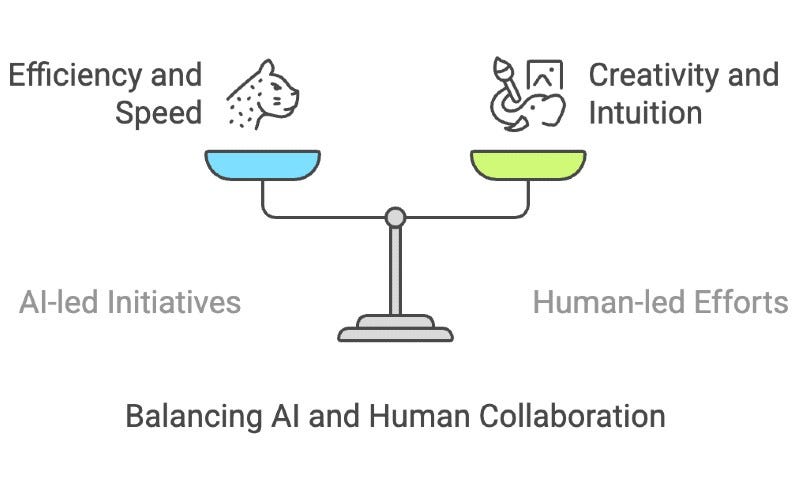Balancing the Human-AI Relationship
Finding a balance in the Human-AI partnership
Rather than thinking of tasks as either "human work" or "AI work," there is a continuum of collaboration between artificial intelligence (AI) and human work. On the far left are pure AI-led initiatives, and on the far right are pure human-led efforts.
The Spectrum of AI and Human Collaboration
Pure AI-Led
In this phase, AI systems operate independently, executing tasks without human intervention. This might include automated processes in industries like manufacturing or data analysis, where AI algorithms perform complex calculations and decision-making.
AI-Led
Here, AI takes the lead but still requires some level of human oversight. Humans may set parameters or provide initial data, while AI optimizes processes and generates insights. It is common in areas like customer service chatbots or recommendation systems.
Balanced
Balanced is the ideal state where AI and humans collaborate effectively. Both parties contribute their strengths: AI handles data processing and analysis, while humans provide creativity, emotional intelligence, and ethical considerations. This balance is crucial in fields such as healthcare, where AI can assist in diagnostics, but human judgment is essential for patient care.
Human-Led
In this scenario, humans are in control, utilizing AI as a supportive tool rather than a leader. Human expertise drives decision-making, with AI assisting in data management or analysis. Human-led efforts are typically preferred in creative industries, where intuition and experience are paramount.
Pure Human-Led
At this end of the spectrum, all tasks are performed by humans without any AI involvement. It's often necessary in situations requiring deep emotional understanding or complex human interactions, such as therapy or certain artistic endeavors.
Understanding the continuum of AI and human work is essential for creating effective use of AI and Human resource using the best of both strengths.
By recognizing where a particular task or project falls on this spectrum, organizations can better allocate resources and design workflows that enhance productivity and innovation.
The Augmentation Mindset: AI as an Amplifier
The most successful small business AI implementations share a common philosophy: using AI to augment human capabilities rather than replace them.
The "augmentation mindset" focuses on:
Freeing up human time by automating routine/repetitive tasks
Enhancing human decisions with better data and analysis
Extending human capabilities into new areas
Scaling human expertise across more customer interactions
When approached this way, AI becomes a powerful force on your team rather than a replacement.




